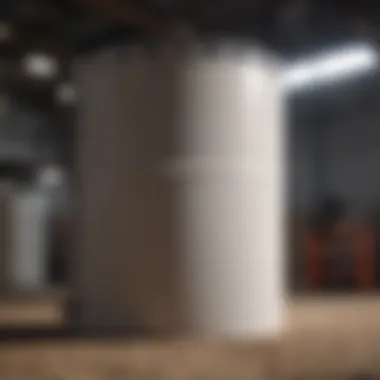Comprehensive Guide on Underground Storage Tank Repair: Importance, Techniques, and Compliance


Overview of the Topic
Underground storage tank (UST) repair is a critical aspect of environmental stewardship and industrial maintenance, ensuring the safety and integrity of these below-ground storage systems. With the potential for leaks and structural deterioration, proactive repair and maintenance measures are indispensable to prevent environmental contamination and maintain regulatory compliance.
Current Status and Challenges
The current landscape of underground storage tank repair presents various challenges stemming from aging infrastructure, corrosion, and inadequate maintenance practices. Instances of leaks or spills can result in soil and groundwater contamination, posing significant risks to environmental and human health. Addressing these challenges requires a thorough understanding of repair techniques and the implementation of stringent preventive measures.
Sustainable Solutions
Exploring sustainable solutions for underground storage tank repair involves adopting best practices such as routine inspections, cathodic protection installation, and corrosion monitoring. Implementing eco-friendly repair materials and techniques, along with proper waste disposal protocols, can minimize the environmental footprint of repair activities. Success stories of effective UST repair strategies emphasize the importance of proactive maintenance and technological advancements in ensuring long-term system functionality.
Impact and Importance
The impact of underground storage tank repair reverberates across ecosystems, communities, and future generations, underscoring the significance of diligent maintenance and repair efforts. Mitigating the environmental repercussions of UST leaks through timely repairs plays a vital role in preserving water quality, safeguarding public health, and upholding regulatory standards. Emphasizing the importance of sustainable resource management, UST repair serves as a cornerstone of environmental conservation and responsible industrial practices.
Introduction to Underground Storage Tank Repair
In comprehending the significance of underground storage tank repair, it is vital to recognize the pivotal role these systems play in various industries. These tanks serve as repositories for essential substances, ranging from fuels to chemicals, ensuring a steady supply for operations. Neglecting maintenance can have dire consequences, leading to environmental hazards, regulatory violations, and operational disruptions. Understanding the importance of proactive repair and maintenance strategies is crucial for optimizing the longevity and performance of underground storage tanks.
Understanding the Significance of Underground Storage Tank Maintenance
The Role of Underground Storage Tanks
The function of underground storage tanks as reservoirs for combustible materials is undeniable. These tanks are built to withstand external elements and secure the contents within. Their design incorporates factors like material strength, corrosion resistance, and leak prevention to maintain the integrity of stored substances safely. However, without proper maintenance, these essential features can deteriorate, compromising both the tank's efficiency and environmental safety.
Impact of Neglected Maintenance
The impact of neglected maintenance on underground storage tanks cannot be underestimated. Failure to address issues promptly can result in leaks, spills, and structural weaknesses, endangering the surrounding ecosystem and necessitating costly remediation measures. Recognizing the consequences of disregarding maintenance illuminates the urgency of implementing regular inspection and repair protocols.


Common Causes of Damage to Underground Storage Tanks
Corrosion
Corrosion stands as one of the primary adversaries of underground storage tanks. Exposure to moisture, chemicals, and other corrosive agents can weaken tank walls, leading to structural vulnerabilities and potential leaks. Understanding the corrosion process and adopting preventive measures are essential to safeguarding tank longevity and content integrity.
Leaks and Spills
The occurrence of leaks and spills in underground storage tanks poses severe environmental and operational risks. Whether due to structural integrity issues or improper handling, leaks can contaminate soil, groundwater, and surrounding water bodies, necessitating immediate intervention and remediation efforts. Delving into the causes of leaks and spills underscores the criticality of comprehensive maintenance practices.
Importance of Timely Repairs in Preserving Tank Integrity
Prevention of Environmental Contamination
Efficient repairs executed in a timely manner play a crucial role in preventing environmental contamination. By addressing issues promptly, the risk of leaks, spills, and soil seepage is mitigated, reducing the potential harm to ecosystems and human health. Prioritizing the prevention of environmental contamination through proactive repair measures aligns with regulatory guidelines and ethical stewardship.
Ensuring Operational Efficiency
Timely repairs not only uphold environmental standards but also safeguard operational efficiency. Maintaining tank integrity and functionality through proactive repairs ensures a continuous and reliable supply of stored materials. By minimizing downtime and optimizing performance, timely repairs contribute to overall operational efficiency and cost-effectiveness.
Techniques for Underground Storage Tank Repair
In this article, Techniques for Underground Storage Tank Repair play a pivotal role in ensuring the longevity and efficiency of underground storage tanks. These techniques encompass various methods that address common issues and enhance the structural integrity of the tanks. By focusing on repair techniques, individuals involved in managing underground storage tanks can proactively maintain these critical systems, minimizing the risk of environmental contamination and operational disruptions.
Repair Methods for Common Tank Issues
Internal Coating
Internal coating involves lining the interior surfaces of underground storage tanks with protective coatings to prevent corrosion and leakage. This method is imperative for minimizing the impact of corrosive substances on tank walls and extending the lifespan of the tank. Internal coatings act as a barrier, reducing the risk of leaks and spills that can result in environmental damage. While internal coating offers significant protective benefits, it requires regular inspection and maintenance to ensure its effectiveness over time.
Cathodic Protection Installation


Cathodic protection installation is a technique used to safeguard underground storage tanks from corrosion by applying a low-voltage electrical current to counteract the natural corrosive process. This method is highly effective in preventing metal degradation and increasing the longevity of tanks in corrosive soil conditions. By mitigating corrosion through cathodic protection installation, tank maintenance costs are reduced, and the overall reliability of the storage system is enhanced. However, proper monitoring and periodic system checks are essential to validate the efficiency of cathodic protection and address any potential issues.
Replacing Damaged Components
Piping
Piping replacement is a critical aspect of underground storage tank repair that involves replacing deteriorated or damaged pipes to maintain the seamless flow of liquids within the system. High-quality piping ensures the safe transfer of substances without the risk of leaks or contamination. Selecting the appropriate piping materials and conducting regular inspections are key factors in preserving the integrity of underground storage tanks. While piping replacement contributes to the overall efficiency and safety of the system, proper installation and adherence to industry standards are essential for long-term functionality.
Gaskets and Seals
Gaskets and seals play a crucial role in preventing leaks and maintaining the structural integrity of underground storage tanks. These components act as barriers to contain hazardous substances and prevent environmental contamination. Choosing durable gaskets and seals that are resistant to corrosion and degradation is essential for ensuring the reliability of the tank system. Regular inspection of gaskets and seals is necessary to identify signs of wear or damage and initiate timely replacements to prevent malfunction.
Utilization of Advanced Repair Technologies
Injection Systems
Injection systems utilize innovative technology to repair underground storage tanks by injecting specialized materials into damaged areas, effectively sealing leaks and restoring structural stability. This advanced repair technique offers a precise and efficient solution for addressing integrity issues in tanks without the need for extensive excavation. Injection systems provide a cost-effective and environmentally friendly method for tank repair, minimizing disruption to operations and reducing repair time. However, proper training and expertise are required to operate injection systems securely and achieve optimal repair outcomes.
Robotic Repairs
Robotic repairs involve the use of automated systems to conduct inspections, maintenance, and repairs on underground storage tanks. These cutting-edge technologies enable remote access to confined spaces and complex tank structures, facilitating accurate assessments and targeted repairs. Robotic repairs enhance safety by minimizing human entry into hazardous environments and improving the overall efficiency of repair operations. While robotic systems offer significant advantages in terms of precision and access, regular maintenance and calibration are essential to ensure their continued functionality and reliability in tank repair processes.
Environmental Considerations in Tank Repair
Preventing Soil and Groundwater Contamination
Soil Remediation Techniques
In the domain of preventing soil and groundwater contamination, one key aspect that emerges prominently is the adoption of soil remediation techniques. This subsection sheds light on the intricate details of soil remediation methodologies and their pivotal role in safeguarding environmental integrity. The unique characteristic of soil remediation techniques lies in their ability to efficiently restore contaminated soil to its natural state, thereby preventing further harm to the surrounding ecosystem. Despite some limitations, the benefits of employing soil remediation techniques in underground storage tank repair outweigh the challenges, making it a preferred choice in this article.
Groundwater Monitoring Practices


Another crucial facet in mitigating soil and groundwater contamination is the implementation of groundwater monitoring practices. This section delves into the significance of monitoring groundwater quality to preempt any potential contamination issues. The key feature of groundwater monitoring practices is their proactive nature, allowing for early detection of pollutants and prompt action to prevent widespread contamination. While not devoid of drawbacks, the advantages of incorporating groundwater monitoring practices in this article far exceed the disadvantages, positioning it as a vital component of environmental safety.
Adherence to Environmental Regulations
EPA Guidelines
Compliance with EPA guidelines stands as a cornerstone in ensuring adherence to environmental regulations during underground storage tank repair activities. The detailed discussion on EPA guidelines elucidates their indispensable role in maintaining environmental standards and fostering sustainable repair practices. A distinctive feature of EPA guidelines is their comprehensiveness, providing a holistic framework for environmental protection and regulatory compliance. Despite certain challenges, the advantages of integrating EPA guidelines in this article are substantial, enhancing operational transparency and environmental responsibility.
Waste Disposal Protocols
Efficient waste disposal protocols are instrumental in upholding environmental regulations and promoting ecological sustainability within tank repair endeavors. This segment outlines the significance of proper waste disposal methods and their positive impact on environmental preservation. The key characteristic of waste disposal protocols lies in their ability to systematically eliminate hazardous materials while minimizing environmental repercussions. Although facing some limitations, the advantages of adhering to meticulous waste disposal protocols in this article cannot be overstated, underlining their pivotal role in regulatory compliance and environmental stewardship.
Ensuring Regulatory Compliance and Safety
In this section, we delve deep into the critical aspect of ensuring regulatory compliance and safety when it comes to underground storage tank repair. Regulatory compliance is of utmost importance in maintaining the integrity of storage systems and mitigating environmental risks. By adhering to industry standards and safety protocols, professionals can ensure that repair operations are conducted efficiently and effectively. Ensuring regulatory compliance not only safeguards the environment but also protects the health and safety of individuals involved in the repair process.
Compliance with Industry Standards
API Standards
API Standards play a pivotal role in guiding underground storage tank repair practices. These standards set forth guidelines and best practices for the installation, maintenance, and repair of storage tanks. The key characteristic of API Standards is their comprehensive nature, covering all aspects of tank management to ensure optimal performance and longevity. Choosing to follow API Standards is advantageous as it provides a universal framework that is recognized and accepted across the industry. One unique feature of API Standards is their focus on continuous improvement and innovation, driving advancements in tank repair technologies and methodologies. While API Standards are highly beneficial in standardizing repair processes, some disadvantages include potential complexities in implementation and the need for regular updates to align with evolving industry practices.
NFPA Regulations
NFPA Regulations offer another layer of compliance for underground storage tank repair. These regulations focus on fire protection and prevention measures, ensuring that tanks are designed and maintained to minimize fire hazards. The key characteristic of NFPA Regulations is their emphasis on safety standards that reduce the risk of fire-related incidents during repair operations. NFPA Regulations are a popular choice for this article due to their systematic approach to addressing potential fire risks associated with storage tank repairs. A unique feature of NFPA Regulations is their detailed protocols for emergency response planning, enhancing preparedness in case of unforeseen events. While NFPA Regulations are beneficial for promoting fire safety, some disadvantages include rigorous compliance requirements that may necessitate additional resources and expertise.
Safety Measures During Repair Operations
In the realm of underground storage tank repair, safety measures during repair operations are paramount to protect workers and the surrounding environment. By implementing stringent safety protocols, such as confined space protocols and emergency response planning, the risks associated with repair activities can be minimized. These measures not only ensure the well-being of personnel but also contribute to the overall success and efficiency of repair projects.
Confined Space Protocols
Confined space protocols focus on safeguarding workers who perform maintenance or repairs within enclosed tank spaces. The key characteristic of confined space protocols is their emphasis on hazard identification and control to prevent accidents and work-related injuries. Choosing to adhere to confined space protocols is a beneficial choice for this article as it promotes a culture of safety and risk mitigation during repair tasks. A unique feature of confined space protocols is their detailed procedures for atmospheric monitoring and ventilation, enhancing worker safety in potentially hazardous environments. While confined space protocols are essential for worker protection, some disadvantages include the requirement for specialized training and equipment to ensure compliance.
Emergency Response Planning
Emergency response planning is vital for handling unexpected incidents that may occur during repair operations. By developing comprehensive response plans, teams can effectively mitigate risks and minimize the impact of emergencies on personnel and the environment. The key characteristic of emergency response planning is its proactive approach to identifying potential hazards and outlining strategies for swift and efficient emergency actions. This article advocates for the inclusion of emergency response planning due to its role in enhancing preparedness and response capabilities in the event of accidents or unforeseen occurrences. A unique feature of emergency response planning is its focus on communication protocols and chain of command, ensuring clarity and coordination in emergency situations. While emergency response planning is crucial for overall safety, some disadvantages may include the initial time and resources required for plan development and implementation.



